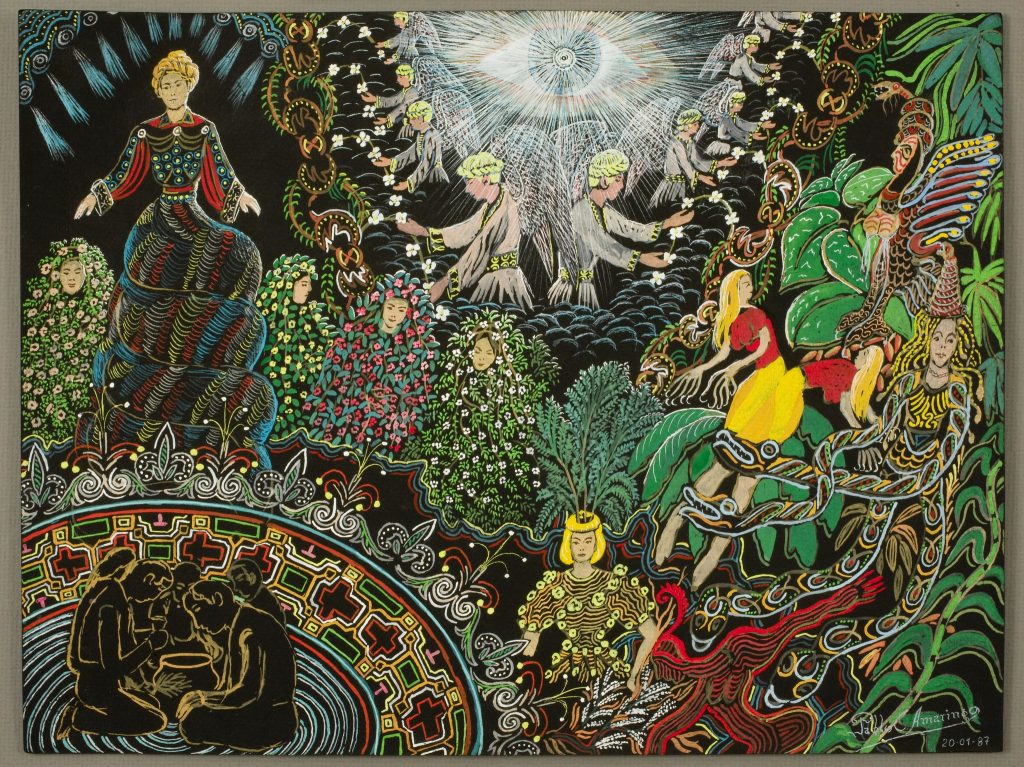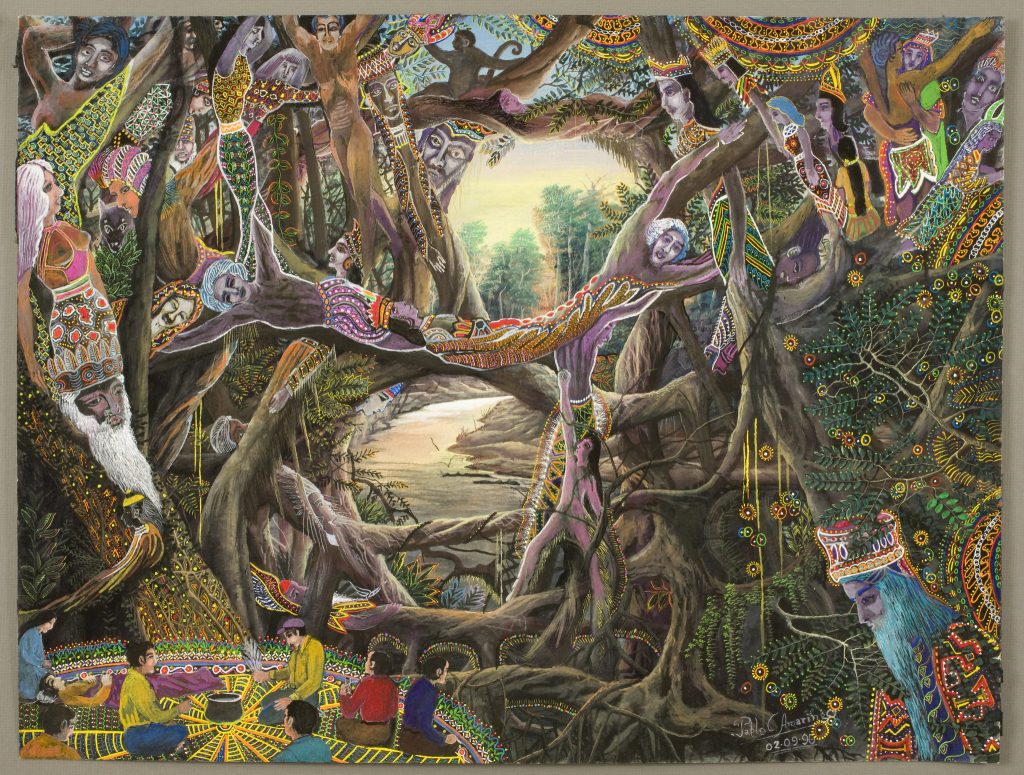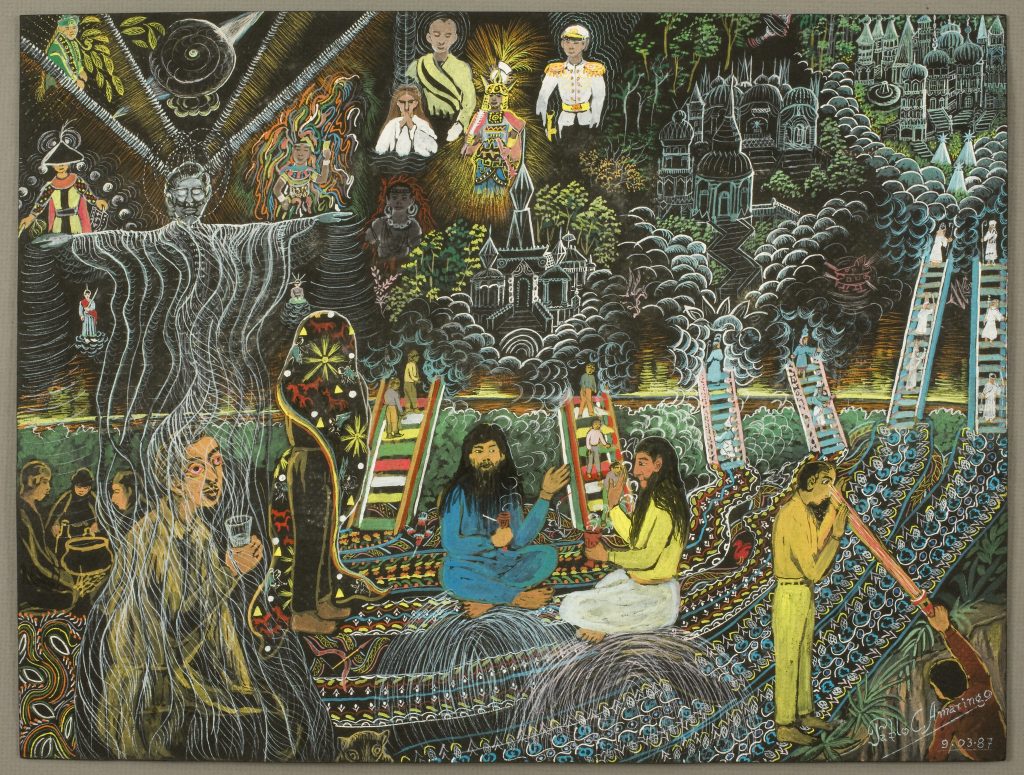Kayla Marcantonio – Pablo Amaringo: “Man and Earth through Visions”
Kayla Marcantonio
The Art:



Introduction:
Pablo Amaringo: “Man and Earth through Visions” is about environmental art focused on the works of Pablo Amaringo through his visionary art and the messages they depict between the relationships of man and Earth. The work of Pablo Amaringo captures very beautifully the idea that man is and should be one with nature and the culture and worship of nature’s importance. Pablo Amaringo’s art is influenced by his visions obtained through drinking ayahuasca[1]. These visions are very colorful and very creatively show the relationship of man and nature with ethereal creature and depictions of humans interacting with nature. These depictions provide a much deeper meaning and understanding of the environment.
Themes:
The first theme in Pablo Amaringo’s work I would like to address is the representation of people as a part of nature. Amaringo incorporates people into nature-like beings, which can be seen above in Espíritus de los Renacos and Untitled, (flower people with angels). These two works represent humanly beings with a naturistic features. For example, in Espíritus de los Renacos Amaringo paints these humans as tree trunks and branches. Another example can be seen in Untitled, (flower people with angels) where Amaringo represents some humans as flowery bush people, a person with snake arms, branches growing out of a head. These representations and the theme of people as a part of nature show where man stands as a part of nature. Specifically in the idea that man is a part of nature and the environment. Or in other words, mans interactions with the environment and nature shows that man and nature are one. The second theme I would like to address is the cultural belonging of humans in this nature. Amaringo portrays this nature-cultural importance and belonging in Incorporation in a Patient, Espíritus de los Renacos, and Untitled, (flower people with angels). In each Amaringo shows these “normal” human beings worshipping the land and nature around them. Each of the three works shows these humans worshipping the nature around them which shows the centrality of nature in culture.
Analysis:
All three works presented in this portfolio are by Pablo Amaringo. Pablo Amaringo is a Peruvian artist who came from an impoverished life as a little boy. He began working at an early age to help support his big family which forced him to give up his education. Suddenly, Amaringo began suffering severe heart problems which led him to become very ill and eventually made him unable to continue working. Amaringo sought care from a local healer and while recovering Amaringo learned medicine using Amazonian plants, eventually becoming a healer. At the same time, he began to create art using what ever he could find around him since he could not afford supplies. Due to his knowledge in medicine with Amazonian plants he drank ayahuasca which gave him these visions that he would then depict in his art. These visions were centered around nature and man and the ethereal. These visions had an extremely high influence in his works. The first work, Untitled, (flower people with angels), was made in 1987 and thoroughly depicts these visions he had showing the interactions between the ethereal nature and man. The second work, Espíritus de los Renacos, was made on September 2nd, 1996. In this work, Amaringo can be seen employing the idea that man and the environment are one and the worship of the ethereal nature with the humans gathered worshipping in the bottom corner. The tree people are very indicative of the visionary presence of his works and show the influence of ayahuasca in his work. The third work, incorporation in a Patient, was made in 1987. This work shows these ethereal beings and and the use of ayahuasca. Additionally, it depicts the worshipping of the ethereal nature surrounding the worshippers. The heavenly fortresses above are decorated with flora further driving the idea of the importance of this nature and the worship of it. All three works and their themes can together be understood today as a message about the importance of the environment and how we humans need to work with the environment and worship it because we are one with it. Without it we cannot exist.
Application:
Pablo Amaringo’s art is extremely important in understanding the Peruvian society in which it was created. Amaringo’s work accurately depicts the nature worship that the indigenous Peruvians took part in. This can be seen through the many depictions of anthropomorphized nature, including both animals and plants, even the Earth itself. The indigenous Peruvians depict their deities in this way. Amaringo’s inclusion and depictions of these deities center around the Peruvian influence and the indigenous people. Additionally, Amaringo’s art work can be seen as a very distinctive way to understand this since all of his work was produced when he was under the influence of ayahuasca. However, it still provides an interesting approach to dive into the Peruvian culture due to his vivid work.
- A brew of South American plants that has hallucinogenic effects. ↵

